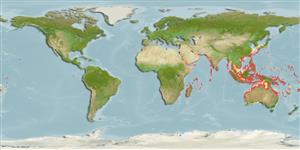Common names from other countries
Environment: milieu / climate zone / depth range / distribution range
Ecologia
; intervalo de profundidade 1 - 50 m (Ref. 4), usually 1 - 8 m (Ref. 4). Tropical; 45°N - 37°S, 30°E - 171°W (Ref. 4)
Indo-West Pacific.
Length at first maturity / Tamanho / Peso / Idade
Maturity: Lm ?, range 4 - 7.86 cm Max length : 50.0 cm TL macho/indeterminado; (Ref. 4); common length : 35.0 cm TL macho/indeterminado; (Ref. 4)
It has a maximum total body length of 50 cm, but usually much smaller (30 to 35 cm) (Ref. 4). It is found in shallow, sometimes slightly turbid coastal waters, from 1 to 8 m depth, with a record of 50 m deep. It inhabits sandy and muddy substrates, sometimes on rocky bottoms, often near the mouth of rivers, but also on coral reefs (Ref. 4). Subtidal (Ref. 106854). Juveniles occur in holes and crevices which are partially covered by seagrass or macroalgae (Ref. 106919). It is solitary, may live in pairs and has been found in larger concentrations (Ref. 4). Omnivore (Ref. 116259).
Members of the order Decapoda are mostly gonochoric. Mating behavior: Precopulatory courtship ritual is common (through olfactory and tactile cues); usually indirect sperm transfer.
Holthuis, L.B. 1991. (Ref. 4)
Status na Lista Vermelha da IUCN (Ref. 130435)
Status no CITES (Ref. 108899)
Not Evaluated
Not Evaluated
Uso pelos humanos
Pescarias: espécies comerciais
| FishSource | Sea Around Us
Ferramentas
Fontes da internet
Estimates based on models
Preferred temperature
(Ref.
115969): 24.6 - 29.3, mean 28.4 (based on 3578 cells).
Resiliência
Elevada, tempo mínimo de duplicação da população menor que 15 meses (K=0.57).
Vulnerabilidade
Moderate vulnerability (40 of 100).
